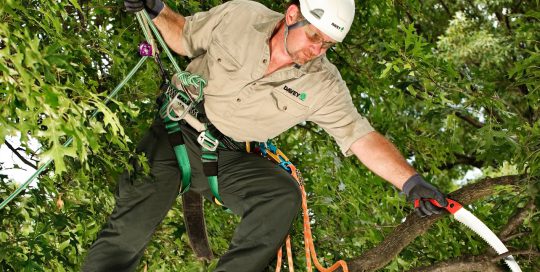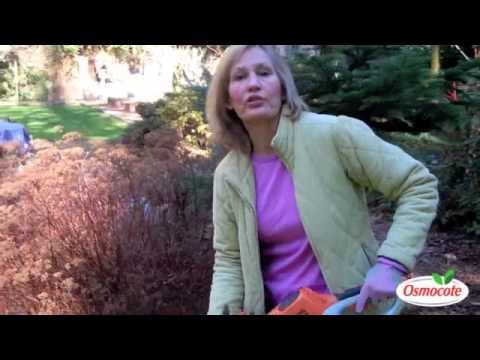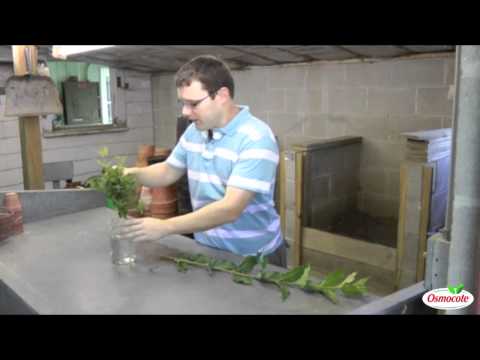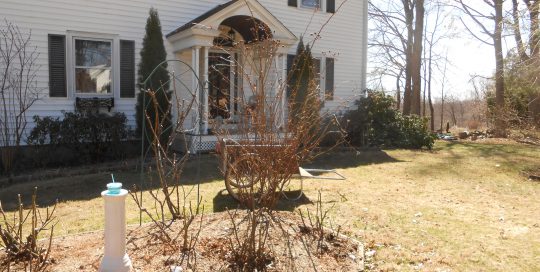Congratulations, you’ve made a commitment to adding container plants and shrubs to your deck or patio. If the pots are planted with perennials, they’ll need to be pruned from time to time in order keep them healthy and sized appropriately. In this article Sarah Marcheschi, staff gardener and feature writer, explains how to prune container plants.
Why growing container plants is a good idea
Whether looking to dress up the deck in your backyard, or to decorate a terrace, containers provide an opportunity to grow varieties of plants that may seem out of reach due to the constraints of light, soil, and space, or even weather. For the most part, growing shrubs in containers is not much different from growing them in the ground. However, they must be watered more frequently, and pruning involves a few extra steps (root pruning, anyone?).

Photo by Sarah Marcheschi
Why container plants need to be pruned
Though shrubs grown in containers sometimes require little in the way of pruning, it is a useful practice as a form of preventive maintenance. This encourages fruit or flower development, and addresses damage from insects or disease. Pruning is also frequently used to change the size and shape of the plant for aesthetic purposes. This can be by fashioning branches into a charming topiary, or preserving a desirable form. The health of your plants can be promoted by removing dead or dying branches, as well as branches that have sustained wind or storm damage.
When to prune container plants
Pruning is best undertaken in the late winter to very early spring, before new growth begins. That way, wounds on the plant are only exposed, (i.e. susceptible to diseases), for a very short time before new growth starts and wounds heal. It is easier to see the shape of the plant before leaves emerge and obscure the structure of the branches. The exceptions to this rule are plants that bloom early in the growing season on growth from the previous year. In this case, you may prefer to hold off on pruning until after they’ve finished blooming. Some notable examples include azaleas, rhododendrons, forsythia,lilacs,magnolias, and bigleaf hydrangeas (Hydrangea macrophylla).
Make sure pruning tools are in good condition
Before getting started, make sure you have the proper tools for the job, and that they are in good condition. Maintain hand saws and pruning / lopping shears by keeping them clean and sharp. This makes your job easier because it improves their performance and allows you to make clean cuts to branches. This not only look better, but heal better and are far less likely to invite disease. A pair of pruning shears is ideal for making cuts up ¾ inches in diameter. The long handles on a set of lopping shears makes it easier to wield when cutting thicker branches.
How to prune container plant roots
When your shrubs live in containers, it is necessary to keep an eye on their roots. Root pruning is a useful – and often necessary – way to control growth and maintain the health and vigor of container grown plants. Eventually roots in containers will fill all the space available to them. Similar to regular top pruning, you can keep plants healthy by trimming back roots and allowing room for new growth. New growth is very important as young roots are the workhorses of the plant. These absorb necessary water and nutrients to a much greater extent than the older roots. Moreover, the older roots occupy much of the space.
As with most top pruning, roots should be cut back in early spring by turning the pot over and removing the plant, if its size will allow you to do so. Shake off any loose dirt to expose the outer edges of the root system. Trim roots, only slightly, all the way around. Then, return your plant to the pot with some new potting soil. If you have large trees or shrubs in your containers use a hand trowel to work your way into the soil from above. Pull roots up from as near to the bottom of the container as you can manage. Trim with care so as to not inflict any unnecessary damage. Then refill the space in your containers with fresh potting soil. Water plants well after pruning. For outdoor container plants, root pruning can be done as soon as the soil is workable in the spring.
How to prune the visible parts of container plants
After roots have been tidied up for spring, turn your attention to the top of the plant. Some pruning of upper branches will help even things out and make up for the root loss. A good rule of thumb is to start by removing any dead, diseased, or damaged branches first. Next, you can focus on giving plants an appealing shape and keeping the center open to light and air circulation.
When pruning deciduous shrubs (the leaves fall off at maturity), you should ideally encourage a natural style of growth for example. Don’t just lop the tops off of tall plants to make them shorter. Instead maintain a more natural shape. When making cuts, always prune back to either a bud or a branch, taking care not to leave any open ends, known as stubs. Stubs are not only unsightly, but they invite disease and decay. When pruning back to a bud, choose one that is outward facing. This way, the new branch will grow in the direction of the plant’s exterior, rather than toward the center of the plant.
Importance of watering and fertilizing after pruning container plants
After you’ve finished pruning, water plants thoroughly, and continue watering them consistently throughout the growing season. The soil in pots tends to dry out quickly during the hot sunny days of summer, especially for plants sitting on patios and decks. Apply fertilizer in the spring after pruning since shrubs grown in the same containers over the course of several seasons, or even just over one season, will consume the nutrients in the potting soil rather quickly. A good program of pruning and fertilizing will help support vigorous growth and contribute to the longevity of all your container grown shrubs.








